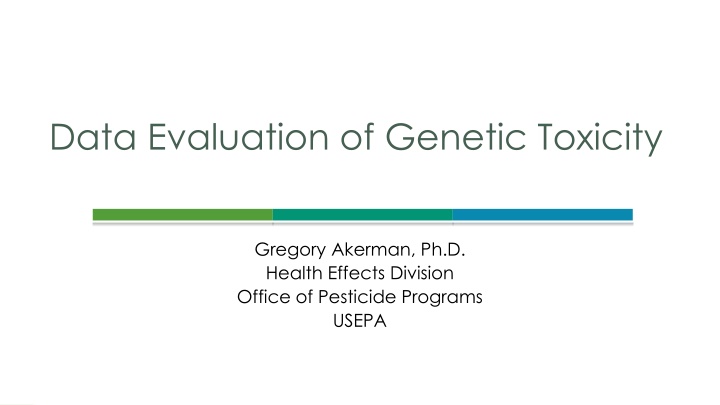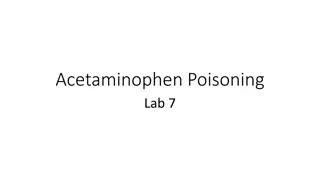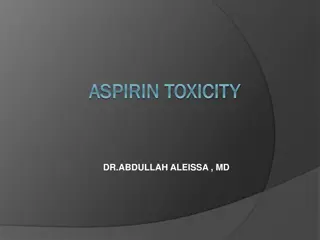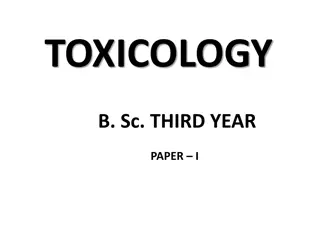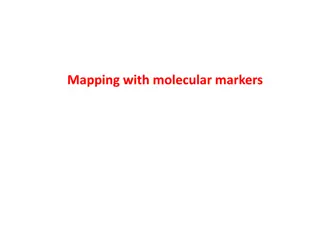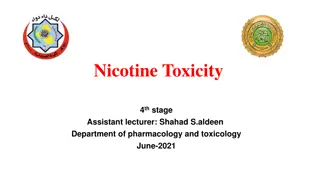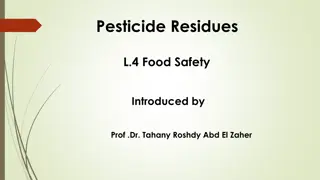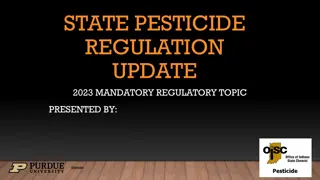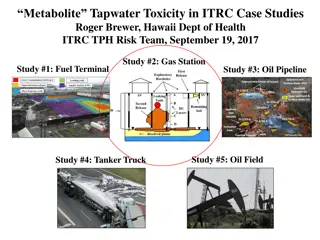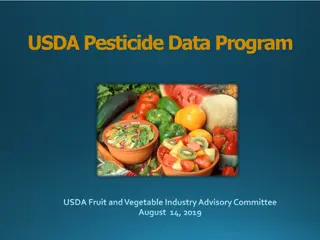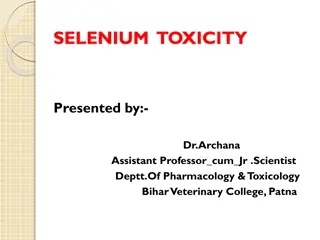Evaluation of Genetic Toxicity in Pesticide Programs - Data Overview
The presentation by Dr. Gregory Akerman discusses the evaluation of genetic toxicity, focusing on genotoxicity data for glyphosate, including gene mutation, chromosomal abnormality, and primary DNA damage. It explores the consequences of genotoxicity, such as cancer risks and cell death, along with the battery of tests used for assessing genetic endpoints. The importance of mutagenicity testing for pesticide registration is highlighted, emphasizing the need for thorough data analysis in regulatory decisions.
Download Presentation

Please find below an Image/Link to download the presentation.
The content on the website is provided AS IS for your information and personal use only. It may not be sold, licensed, or shared on other websites without obtaining consent from the author.If you encounter any issues during the download, it is possible that the publisher has removed the file from their server.
You are allowed to download the files provided on this website for personal or commercial use, subject to the condition that they are used lawfully. All files are the property of their respective owners.
The content on the website is provided AS IS for your information and personal use only. It may not be sold, licensed, or shared on other websites without obtaining consent from the author.
E N D
Presentation Transcript
Data Evaluation of Genetic Toxicity Gregory Akerman, Ph.D. Health Effects Division Office of Pesticide Programs USEPA
Outline of Presentation Background information Sources of genotoxicity data Genotoxicity data for glyphosate Gene mutation Chromosomal abnormality (in vitro and in vivo) Primary DNA damage Assessment of the available data Conclusions 2
Genotoxicity Genotoxicity- damage to genetic material Transient or permanent: Transient DNA damage refers to unintended modifications to the structure of DNA, which may or may not undergo successful repair. Permanent DNA damage refers to heritable changes in the DNA sequence, known as mutations. Consequences of genotoxicity: May cause cancer if the mutations occur within regulatory genes May signal the cell to undergo apoptosis (cell death) and the damage is not fixed as a mutation and is not passed along to daughter cells. 3
Genotoxicity Battery of genotoxicity tests used to adequately cover all the genetic endpoints important for regulatory decisions. EPA considers genotoxicity information as part of the weight of evidence when assessing the potential of a chemical to induce cancer in humans. 4
Genotoxicity Mutagenicity Testing for Pesticide Registration: Part 158.500 requires mutagenicity testing for all food and non- food use pesticides Current mutagenicity battery of tests: 1) Bacterial reverse mutation test 2) in vitro mammalian (forward) gene mutation and in vitro mammalian chromosomal aberration tests 3) in vivo test for micronucleus induction or in vivo chromosomal aberration test 5
Sources of Genotoxicity Data Fit-for-purpose systematic review identified relevant genotoxicity data from regulatory studies and published literature. Studies limited to mammalian-based assays and conventional mutagenicity studies in bacteria. Studies for glyphosate technical and glyphosate-based formulations were identified. Identified regulatory studies that were not previously available to the agency. 6
Sources of Genotoxicity Data Studies identified in systematic review cross-referenced with published review articles and recent international evaluations of glyphosate. Analysis also includes 17 genotoxicity studies for glyphosate technical that were included in Kier and Kirkland review article (2013), but were not available to the agency. Summary data files for these studies were provided online by the publisher. 7
Assessment of Genotoxicity Data The quality of the published and unpublished data were evaluated for inclusion in the analysis: Considered the study design, data reporting, and how well the study was conducted. Critical elements, such as test conditions (e.g. solubility, pH, osmolarity, and cytotoxicity) and study design (e.g. number of test organisms, doses selected, use of positive and negative controls; blinded evaluation) were used to evaluate the quality of published and non-published studies. In cases where inappropriate testing conditions or study design clearly had an impact on the outcome the study, the study was excluded from the analysis. 8
Genotoxicity Data Assays to Detect Gene Mutations Bacterial mutagenicity tests e.g., Salmonella and E. coli tester strains (Ames test) In vitro mammalian cell gene mutation tests e.g., CHO/HPRT, mouse lymphoma L5178Y TK+/- cells Assays to Detect Chromosomal Damage In vitro and in vivo chromosomal aberration and micronucleus tests Assays to Detect Primary DNA Damage e.g., Comet assay, Unscheduled DNA synthesis (UDS) 9
Evaluation of Genotoxicity Data Factors influencing the weight given to genotoxicity findings: Permanent DNA damage versus transient DNA damage i.e. chromosomal damage versus primary DNA damage In vivo findings versus in vitro findings Route of administration e.g. oral (gavage/diet) versus intraperitoneal injection (i.p.) The relevance of administered dose for human health risk assessment. 10
In Vitro Mutagenicity Findings Bacterial Mutation Assays 27 studies/assays evaluating glyphosate technical All assays were negative for inducing mutations with and without metabolic (S9) activation In vitro Tests for Gene Mutations in Mammalian Cells 4 studies identified 1 assay using CHO cells (HPRT locus) 3 mouse lymphoma assays (L5178Y cells) All four assays were negative with and without metabolic (S9) activation 11
In vitro Tests for Chromosomal Abnormalities In vitro chromosomal aberration (CA) tests 6 out of 8 were negative. 3 studies were negative using cell lines 2 studies using lymphocytes were positive for CA induction: One study positive at 8.5 M glyphosate in bovine lymphocytes, (Lioi et al., 1998b). One study positive at 7 M glyphosate in human lymphocytes, (Lioi et al., 1998a). 3 studies other studies using lymphocytes were negative for CA induction when tested up to much higher concentrations: One study in bovine lymphocytes: Negative up to 1120 M glyphosate, (Sivikova and Dianovsky, 2006). Two studies in human lymphocytes: Negative up to 6000 M glyphosate, (Fox, 1998; Manas et al., 2009). 12
In vitro Tests for Chromosomal Abnormalities In vitro micronucleus tests 4 out of 6 studies were positive and 2 showed equivocal results. 3 positive responses required S9 activation, 2 conducted with human lymphocytes. 1 conducted with CHO cells. 1 positive study conducted using a TR146 cells (a tumor cell line derived from human buccal mucosa). Glyphosate was also negative in all three L5178Y mouse lymphoma cell studies which may detect chromosomal damage in addition to gene mutations. 13
In vivo Tests for Chromosomal Abnormalities 3 in vivo mammalian bone marrow chromosomal assays All negative for CA induction in vivo. Sprague Dawley rats: i.p. injection (glyphosate;1000 mg/kg) Sprague Dawley rats: oral gavage (glyphosate trimesium salt;188 mg/kg) Swiss albino mice: oral gavage (glyphosate; 5000 mg/kg) 2 in vivo rodent dominant lethal tests Both studies negative for inducing dominant lethal mutations. CD-1 mice: oral gavage (glyphosate; up to 2000 mg/kg/day) Wistar Rats: oral gavage (glyphosate; up to 5000 mg/kg/day) 14
In vivo Tests for Chromosomal Abnormalities In vivo mammalian micronucleus assays 19 studies regulatory, open literature, and 1 by National Toxicology Program (NTP). 9 studies in mice with administration of glyphosate by the intraperitoneal (i.p.) route 10 studies with administration of glyphosate by the oral route. 8 mouse studies via oral gavage 1 mouse study via dietary administration (NTP study) 1 rat study via oral gavage 15
In vivo Tests for Chromosomal Abnormalities In vivo Micronucleus: I.P. Administration 7 out of 9 i.p. studies negative for induction of bone marrow micronuclei Tested doses as high as 2016 mg/kg (single and double administration) with sampling times at 24 and 48 hours post-dose. 2 positive findings: Bolognesi et al. (1997) in male Swiss CD mice (3/dose), 24 hours 300 mg/kg (administered as doses, 24 hours apart) Manas et al. (2009) in male and female BALB/c mice (5/sex/dose) administered 200 mg/kg by two i.p. injections, 24 hours apart. 16
In vivo Tests for Chromosomal Abnormalities In vivo Micronucleus: Oral Gavage Administration 8 out of 9 oral studies in the mouse were negative for micronuclei induction up to 5000 mg/kg/day glyphosate. 1 positive response seen in female mice treated with two 5000 mg/kg (limit dose) doses, 24 hours apart with sampling at 24 hours post-dose (Suresh, 1993b). Negative at all doses in males in this study. 1 study evaluated micronuclei induction in rats, glyphosate negative up to 2000 mg/kg. No significant increase in micronucleated erythrocytes were seen in male or female mice following 13-weeks of dietary (feed) administration of glyphosate technical at doses up to 3393 mg/kg/day (NTP, 1992). 17
Genotoxicity Assays Evaluating Primary DNA Damage Systematic review identified a number of genotoxicity assays that evaluate primary DNA damage, but do not measure the consequence of the genetic damage (i.e., mutation or chromosomal damage). Endpoints measured in primary DNA damage tests such as DNA adducts, comet assay, or unscheduled DNA synthesis may lead to cell death or may initiate DNA repair, rather than a mutation. 18
Genotoxicity Assays Evaluating Primary DNA Damage Glyphosate technical did not form DNA adducts in mice when tested via i.p. injection up to 270 mg/kg. Bolognesi et al. (1997) Increase in oxidative damage biomarker 8-hydroxydeoxyguanosine (8-OHdG) in the liver 24 h after i.p. injection of 300 mg/kg glyphosate in mice. No increase in 8-OHdG seen in the kidney. The i.p. dose was within the i.p. LD50 range (134- 545 mg/kg) that has been reported elsewhere (WHO, 1994). 19
Genotoxicity Assays Evaluating Primary DNA Damage Glyphosate negative in 2 unscheduled DNA synthesis (UDS) assays with rat primary hepatocytes. Also negative in a DNA repair test conducted in bacteria (Rec-A test). In alkaline elution assay, increase in single strand breaks (i.e. increased DNA elution rate) in the liver and kidney 4 hours after a single i.p. injection of 300 mg/kg. The elution rate returned to control at 24 hours. 20
Genotoxicity Assays Evaluating Primary DNA Damage 5 studies evaluated glyphosate using the single cell gel electrophoresis assay (comet assay) All studies reported positive findings; however, some issues were identified in the review of the studies that limit the impact of findings. 2 studies conducted using tumor cell lines 2 studies conducted in human lymphocytes 1 study reported positive- tail length only (0.7-700 M) 1 study reported positive tail intensity (-S9 3.5 g/mL; +S9 580 g/mL). 14 day drinking water study in mice treated; 40 and 400 mg/kg/day Reported positive findings at both doses in blood and liver cells No positive control; no indication if scorers were blind to treatment; the biological significance of the magnitude of changes observed is questionable. 21
Other Genotoxicity Assays Sister Chromatid Exchange (SCE) assays. Molecular mechanisms underlying the observation of SCEs are unclear, therefore data from this test were given low weight in the overall analysis. Mixed results observed in studies evaluating in vitro chromosomal alterations with glyphosate treatment. 3 SCE studies reported positive findings with bovine and human lymphocytes. However, the SCE responses were weak and not concentration dependent. Cell transformation assay Glyphosate trimesium salt was negative in the in the Balb/3T cell transformation assay up to 5.0 mg/ml. 22
Summary The genotoxic potential of glyphosate has been extensively investigated using a variety of test systems and genetic endpoints. Totality of the genetic toxicology information was evaluated using a weight of evidence approach. Involved the integration of in vitro and in vivo results as well as an overall evaluation of the quality, consistency, reproducibility, magnitude of response, dose-response relationship and relevance of the findings. Studies evaluating endpoints that measured gene mutations and chromosomal alterations were given more weight than endpoints reflecting DNA events that may be transient or reversible. In vivo studies in mammals were given the greatest weight with more weight given to doses and routes of administration that were considered relevant for evaluating genotoxic risk based on human exposure to glyphosate. 23
Summary Evidence of primary DNA damage: Glyphosate technical is not considered to be electrophilic and did not induce DNA adducts in the liver or kidney. Evidence of DNA strand breaks were reported in a number mammalian cell studies using the comet assay. Additionally, transient increases in alkali labile sites in the liver and kidney of mice. However, due to technical limitations identified in a number of these studies (e.g. use of cancer cell lines that have not been well- characterized, atypical exposure protocols and no indication of blind to treatment), caution should be exercised in interpreting the results. 24
Summary Evidence of In vitro genemutations: Glyphosate technical was negative in all studies for mutagenicity in bacteria and in mammalian cells in vitro. Evidence of chromosomal alterations: Mixed results were observed in studies evaluating in vitro chromosomal alterations with glyphosate treatment. All 3 in vivo mammalian studies evaluating chromosomal aberrations with glyphosate technical were negative. Glyphosate was also negative in a rodent dominant lethal test. Glyphosate was negative in 16 of the 19 bone marrow micronucleus studies evaluated. In 2 of the positive studies, glyphosate technical was administered by i.p. injection (200-300 mg/kg). The only other positive finding was in an oral study at 5000 mg/kg. 25
Conclusions Overall weight of evidence indicates no convincing evidence that glyphosate induces mutations in vivo via the oral route. When administered by i.p. injection, the micronucleus studies were predominantly negative. Limited evidence for genotoxic effects in some in vitro experiments, but in vivo effects were given more weight than in vitro effects particularly when the same genetic endpoint was evaluated. Only positive findings reported in vivo were seen at relatively high doses that are not relevant for human health risk assessment. Charge Question #4 26
Overview of Registration and Carcinogenic Potential Systematic Review and Data Collection Data Evaluation of Epidemiology Studies Data Evaluation of Animal Carcinogenicity Studies Data Evaluation of Genetic Toxicity Data Integration and Weight-of Evidence Analysis Across Multiple Lines of Evidence 27
